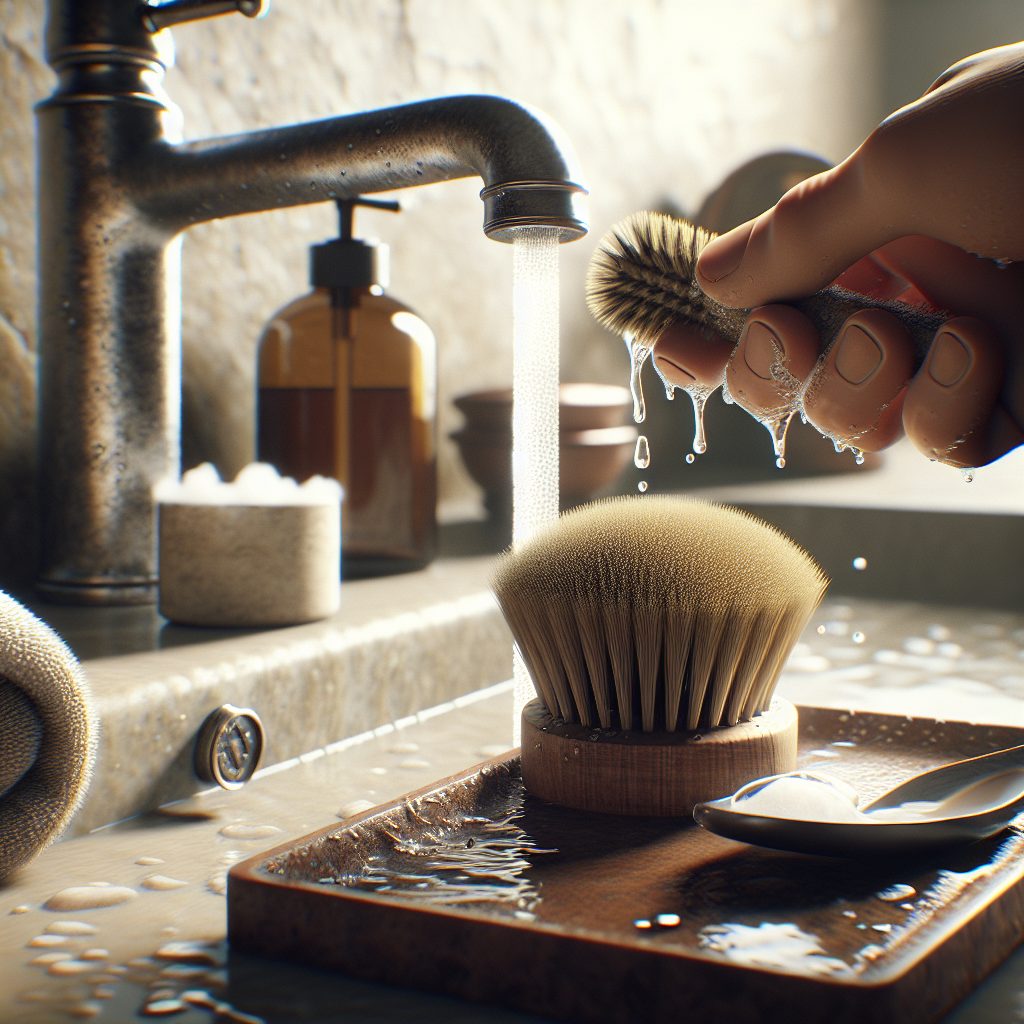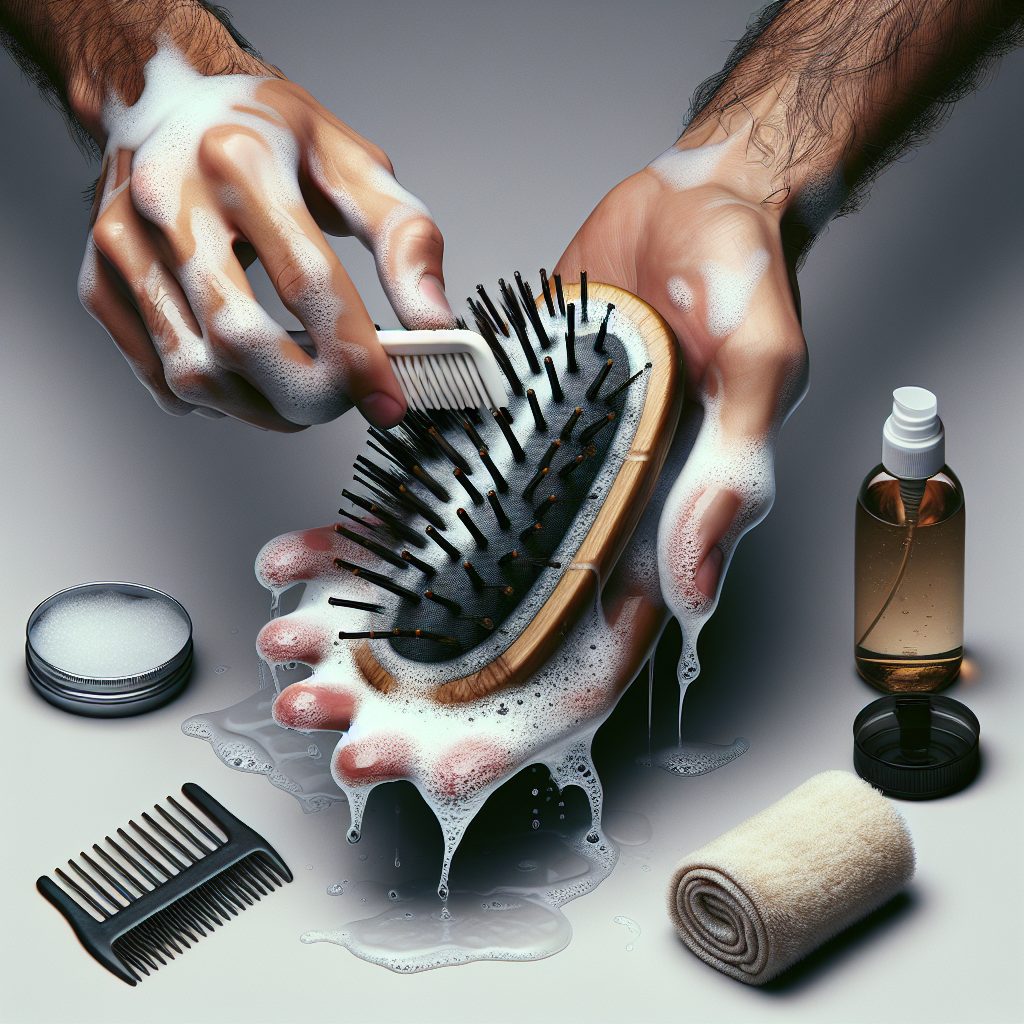
At the heart of a well-groomed beard lies a tool often overlooked yet crucial for maintaining facial hair‘s health and aesthetics: the beard brush. Crafted to untangle, soften, and evenly distribute natural oils, the gentle bristles navigate through the maze of facial hair, capturing dead skin and residue that can dull a beard’s luster. Left unchecked, these build-ups can not only degrade the quality of the brush but can lead to skin irritations, hindered hair growth, and an unkempt appearance. Cleaning your beard brush is an integral part of personal care that preserves the brush’s integrity and ensures that your grooming routine remains hygienic and effective.
Embarking on the journey of preserving your beard’s splendor involves more than just a cursory rinse of your trusted tool. In the next part of our discussion, we’ll delve into the essential techniques and best practices for keeping your beard brush clean, ensuring its longevity, and maintaining its efficacy. We’ll explore the key takeaways that include selecting the right cleaning agents, the step-by-step process to eradicate debris without damaging the bristles or handle, and the drying practices that will prepare your brush for its next use. These insights promise to engender a meticulous care regimen that will not only uphold the brush’s function but also contribute to a fuller, healthier beard worthy of admiration.
Key Takeaways
1. Cleaning a beard brush is essential for maintaining good hygiene and ensuring the brush performs effectively. It involves removing trapped hairs routinely and washing the brush with soap and water every few weeks to remove dirt, oil, and any lingering skin cells.
2. To begin the cleaning process, one should gently pull out the hairs from the brush using a comb or fingers. A beard pick or comb can be particularly useful for detangling hairs from bristle brushes without causing damage to the bristles.
3. After detangling and removing loose hairs, the brush should be washed using a mild shampoo or soap. A toothbrush can be used to scrub between the bristles, reaching the base of the brush where oils and skin cells can accumulate.
4. After thoroughly scrubbing the brush, it should be rinsed with clean water to remove all soap residues. It is important to rinse until the water runs clear to ensure that no cleaning product is left behind, which could irritate the skin when the brush is reused.
5. Post-cleaning, the beard brush should be dried to prevent the growth of mold or mildew. This can typically be done by shaking off excess water and laying the brush bristle-side down on a clean towel to air dry completely before the next use.
What Is the Best Way to Clean Your Beard Brush?
Understanding the Importance of Regularly Cleaning Your Beard Brush
Beard brushes are essential tools for grooming and maintaining facial hair. They help to distribute natural oils, remove dandruff, and keep hair untangled. However, with consistent use, brushes can accumulate dead skin cells, product residue, and other impurities, making it crucial to clean them regularly to maintain a healthy beard and skin.
Identifying When to Clean Your Beard Brush
A key factor in beard brush maintenance is knowing how often to clean it. Typically, inspecting the brush after every use for trapped hairs and weekly for signs of build-up is recommended. Factors such as the frequency of use, the type of products applied to the beard, and personal skin and hair type influence how often cleaning should occur.
Step-by-Step Guide to Cleaning Your Beard Brush
- Start by removing trapped hairs from the bristles. Use a comb or your fingers to gently pull out the hair.
- Prepare a solution of warm water and mild soap or shampoo, optimized for the type of bristles your brush possesses.
- Dip the bristles in the cleaning solution. Gently swish the brush around or use your fingers to work the soap through the bristles.
- Rinse the brush by running it under lukewarm water. Make sure that all soap is washed out to prevent residue from building up in the bristles.
- Shake off the excess water and gently pat the bristles with a clean towel to remove moisture.
- Lay the brush bristle-side down on a clean towel to air dry completely before the next use.
Selecting the Right Cleaning Agents for Different Beard Brush Types
The choice of cleaning agent is fundamental for preserving the quality of the brush. Brushes with natural bristles may require different care than those with synthetic bristles. For instance, gentle shampoos are advised for natural bristles, while synthetic bristles can be cleaned with slightly stronger soap solutions without causing damage.
Dealing with Stubborn Residue and Disinfecting the Beard Brush
For brushes with stubborn residue, using an old toothbrush can help scrub between the bristles. When it comes to disinfecting, a diluted apple cider vinegar solution can serve as an effective natural disinfectant, being careful to rinse the brush thoroughly afterward.
Maintaining Your Beard Brush for Longevity
Aside from cleaning, regular maintenance, such as storing the brush in a dry place and avoiding direct exposure to heat or sunlight, can extend its life. Substituting cleaning products with natural alternatives can also prevent wear on the bristles, ensuring your beard brush stands the test of time.
Are There Any Special Tips for Ensuring a Thoroughly Clean Beard Brush?
- Avoid soaking a wooden brush handle in water to prevent warping or damage to the wood.
- Do not use abrasive cleaners or chemicals that can damage the bristles or handle of the brush.
- Ensure your brush is completely dry before using it again to prevent bacteria growth.
- Consider using a beard brush cleaner tool specifically designed to reach into the bristles for a deeper clean.
What is the best way to clean a beard brush?
To properly clean a beard brush, start by removing loose hair with a comb. Then, create a solution of warm water and gentle shampoo or soap, and gently scrub the bristles using your fingers or a toothbrush. Rinse thoroughly with water and let the brush air dry with bristles facing down.
How often should I clean my beard brush?
Cleaning frequency depends on use, but it’s generally recommended to clean your beard brush once a week to keep it free of dirt, oil, and dead skin cells that can accumulate between the bristles.
Can I use any soap to clean my beard brush?
It’s best to use a gentle shampoo or beard cleanser to clean your brush. Harsh detergents can damage the bristles and potentially irritate the skin when you use the brush again.
Is it necessary to disinfect my beard brush?
Disinfecting your beard brush occasionally, especially if you’ve had any skin infections, can help maintain hygiene. You can use a mild disinfectant solution or rubbing alcohol to disinfect the bristles.
Can water damage my beard brush?
Water can damage wooden beard brush handles if submerged or left wet for extended periods. It’s important to dry your brush properly, focusing on removing water from the handle and the bristles after cleaning to prevent damage.
How do I remove stubborn residue from the bristles?
For stubborn residue, use a finer-toothed comb to gently work between the bristles or increase the concentration of shampoo in your cleaning solution. Let the bristles soak for a couple of minutes before scrubbing and rinsing.
Should the brush be dry before using it again?
Yes, it’s important to let your beard brush dry completely before using it again to avoid any mildew growth and to maintain the integrity of the bristles and handle.
Can I use a hairdryer to speed up the drying process?
Using a hairdryer on a cool setting at a safe distance can help speed up the drying process. However, avoid high heat, as it can damage the bristles and warp a wooden handle.
How do I prevent mold from growing on my beard brush?
To prevent mold growth, clean your brush regularly, rinse it thoroughly to remove all soap residue, shake off excess water, and dry it in a well-ventilated area with bristles facing down.
Are there any materials I should avoid when selecting a beard brush to make cleaning easier?
Brushes with non-porous materials like high-quality plastic or metal for the handle and synthetic bristles tend to be easier to clean and less prone to water damage. Choose materials that resist moisture and are durable for long-term use.
Final Thoughts on Cleaning Your Beard Brush
Cleaning your beard brush is not just a matter of personal hygiene; it’s also about preserving the life and effectiveness of the tool that plays a pivotal role in grooming your beard. Regular, thorough cleanings ensure bristle flexibility and hygiene, providing a comfortable experience when brushing. Additionally, proper maintenance of your beard brush can prevent potential skin issues caused by bacteria and build-ups. With the right care, your trusted beard brush can serve you well for years, keeping your beard looking impeccably groomed and healthy.
Remember that the material of your beard brush plays a significant role in how you should care for it. Following the manufacturer’s care instructions and our outlined tips on cleaning and drying will help protect your investment. A well-maintained beard brush is not just a reflection of your commitment to grooming but also an essential tool that can enhance the appearance and health of your beard.

